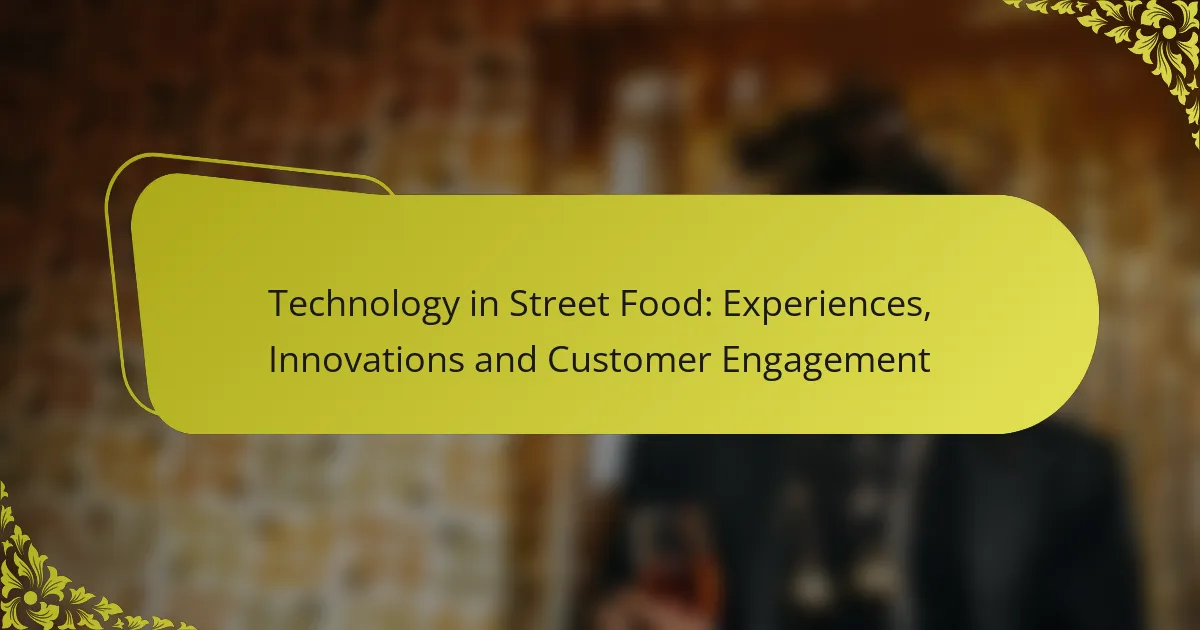Technology is revolutionizing the street food landscape by enhancing ordering, payment, and customer interaction processes. Innovations such as smart food carts and IoT applications are not only improving operational efficiency but also fostering engaging dining experiences. As customers embrace these advancements, vendors can better connect with patrons and tailor their offerings to meet evolving preferences.

How Is Technology Enhancing Street Food Experiences?
Technology is significantly improving street food experiences by streamlining ordering, payment, and customer interaction. These innovations not only enhance convenience but also create engaging and interactive dining experiences for customers.
Mobile ordering apps
Mobile ordering apps allow customers to browse menus, place orders, and pay directly from their smartphones. This convenience reduces wait times and helps vendors manage busy periods more effectively. Popular apps like Uber Eats and DoorDash have expanded their services to include street food vendors, making it easier for customers to access their favorite dishes.
When implementing a mobile ordering system, vendors should consider user-friendly interfaces and reliable customer support. Offering promotions through these apps can also attract more users and increase sales.
Augmented reality menus
Augmented reality (AR) menus provide an interactive way for customers to view food options. By scanning a QR code with their smartphones, customers can see 3D representations of dishes, enhancing their decision-making process. This technology can make the menu more engaging and visually appealing, encouraging customers to try new items.
To implement AR menus, vendors should invest in quality graphics and ensure that the technology is accessible to all customers. Regular updates to the menu can keep the experience fresh and exciting.
Contactless payment systems
Contactless payment systems enable customers to pay quickly and securely using mobile wallets or contactless cards. This technology minimizes physical contact, which is particularly important in maintaining hygiene standards. Popular options include Apple Pay, Google Pay, and various NFC-enabled credit cards.
Vendors should ensure that their payment systems are compatible with multiple payment methods to cater to a broader audience. Clear signage indicating accepted payment options can enhance customer convenience and satisfaction.
Food tracking technology
Food tracking technology allows customers to trace the origin and journey of their meals, providing transparency and building trust. This technology can include QR codes that link to information about ingredients, sourcing, and preparation methods. Customers increasingly value knowing where their food comes from and how it is prepared.
Vendors can leverage food tracking to highlight local sourcing and sustainability efforts, appealing to environmentally conscious consumers. Regularly updating tracking information can keep customers engaged and informed.
Social media engagement
Social media platforms are essential for street food vendors to connect with customers and promote their offerings. Engaging content, such as behind-the-scenes videos or customer testimonials, can enhance brand loyalty and attract new customers. Platforms like Instagram and Facebook are particularly effective for showcasing visually appealing dishes.
Vendors should actively respond to customer inquiries and feedback on social media to foster a sense of community. Running contests or promotions can also increase visibility and encourage customer participation.
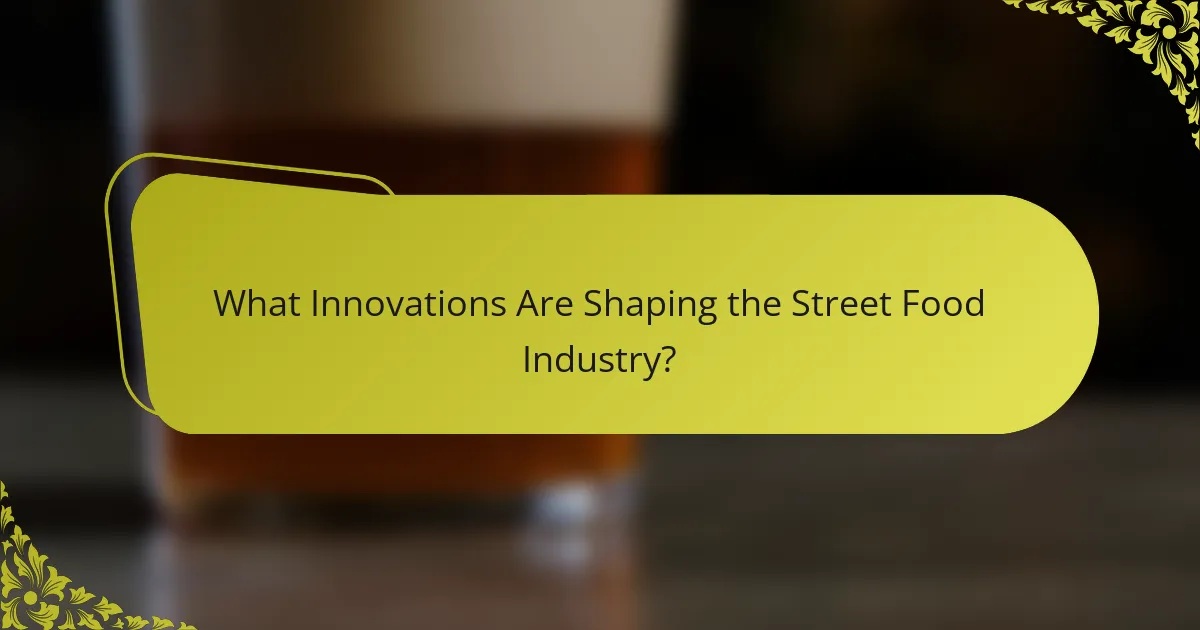
What Innovations Are Shaping the Street Food Industry?
Innovations in the street food industry are transforming how vendors operate and engage with customers. Key advancements include smart food carts, IoT applications for food safety, blockchain technology for supply chain transparency, and 3D food printing.
Smart food carts
Smart food carts integrate technology to enhance operational efficiency and customer experience. These carts often feature built-in payment systems, GPS for location tracking, and digital menus that can be updated in real-time. For example, a vendor can adjust their offerings based on ingredient availability or customer preferences, improving service and reducing waste.
When considering smart food carts, vendors should evaluate the initial investment against potential increases in sales and customer satisfaction. Additionally, ensuring reliable internet connectivity is crucial for maintaining these systems.
IoT in food safety
The Internet of Things (IoT) plays a vital role in ensuring food safety within the street food sector. Sensors can monitor temperature and humidity levels in real-time, alerting vendors to any deviations that could compromise food quality. This proactive approach helps prevent foodborne illnesses and enhances customer trust.
Street food vendors should invest in IoT devices that comply with local food safety regulations. Regular maintenance and updates of these devices are essential to ensure accurate monitoring and reporting.
Blockchain for supply chain transparency
Blockchain technology offers a secure method for tracking food products from source to consumer, enhancing transparency in the street food supply chain. By recording each transaction on a decentralized ledger, vendors can provide customers with information about the origin of their ingredients, fostering trust and accountability.
Vendors interested in blockchain should partner with suppliers who are already utilizing this technology. Implementing blockchain can also differentiate a business in a competitive market, appealing to consumers who prioritize sustainability and ethical sourcing.
3D food printing
3D food printing is an emerging technology that allows vendors to create intricate food designs and customize meals on demand. This innovation can reduce food waste by using precise amounts of ingredients and can cater to dietary restrictions more easily. For instance, a vendor could print a gluten-free pasta dish tailored to a customer’s preferences.
While 3D food printing can attract attention and offer unique culinary experiences, vendors should consider the cost of equipment and training. Additionally, ensuring that the printed food meets taste and quality standards is essential for customer satisfaction.
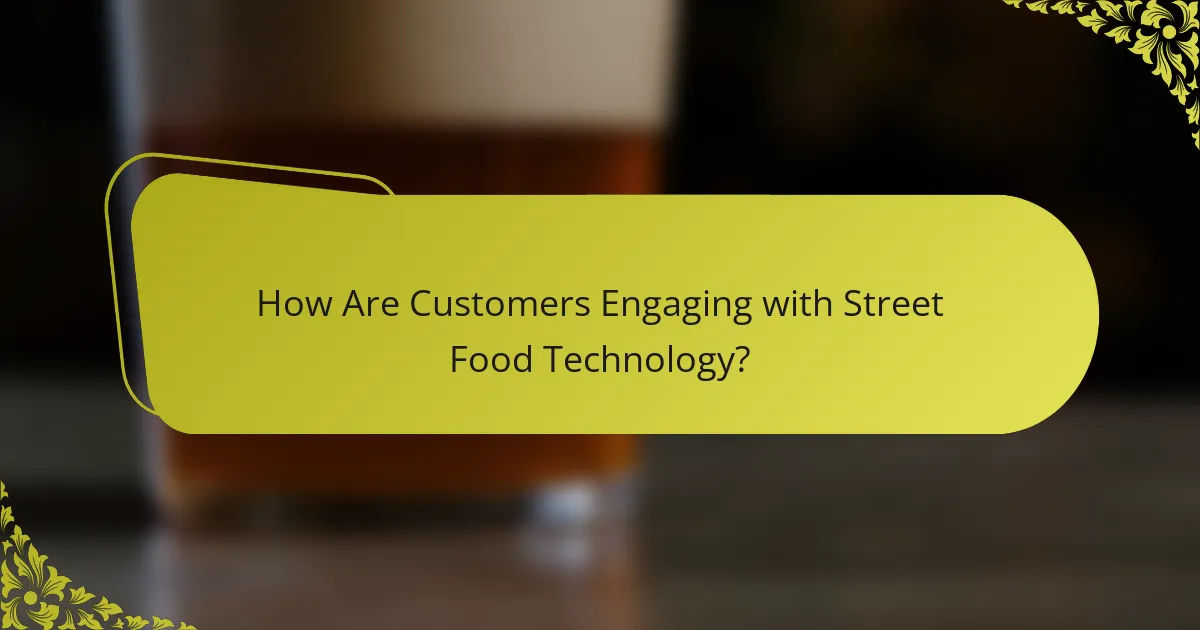
How Are Customers Engaging with Street Food Technology?
Customers are increasingly engaging with street food technology through innovative experiences, feedback platforms, and loyalty programs. These tools enhance the overall dining experience, allowing vendors to connect with patrons more effectively and tailor offerings to meet their preferences.
Interactive food experiences
Interactive food experiences allow customers to participate in the cooking process or customize their meals. For instance, some street food vendors offer build-your-own options where patrons can select ingredients in real-time, creating a personalized dish. This engagement not only enhances satisfaction but also fosters a sense of ownership over the meal.
Additionally, technology such as augmented reality (AR) can be used to provide immersive experiences, allowing customers to visualize their food preparation or learn about the origins of ingredients. This trend is particularly appealing to younger consumers who value unique and memorable dining experiences.
Customer feedback platforms
Customer feedback platforms enable street food vendors to gather insights directly from their patrons. Tools like online surveys, social media polls, and review sites allow customers to share their opinions on food quality, service, and overall experience. This feedback is crucial for vendors to understand customer preferences and make necessary adjustments.
Moreover, leveraging platforms like Google Reviews or Yelp can enhance visibility and attract new customers. Vendors should actively monitor these channels and respond to feedback to demonstrate commitment to customer satisfaction and continuous improvement.
Loyalty programs through apps
Loyalty programs integrated into mobile apps are becoming popular among street food vendors. These programs reward repeat customers with discounts, free items, or exclusive offers, encouraging them to return. For example, a vendor might offer a free meal after a certain number of purchases, which can significantly boost customer retention.
Implementing a loyalty app can streamline the process, allowing customers to track their rewards easily. Vendors should ensure that the program is user-friendly and promotes engagement, such as through gamification elements, to keep customers interested and coming back for more.
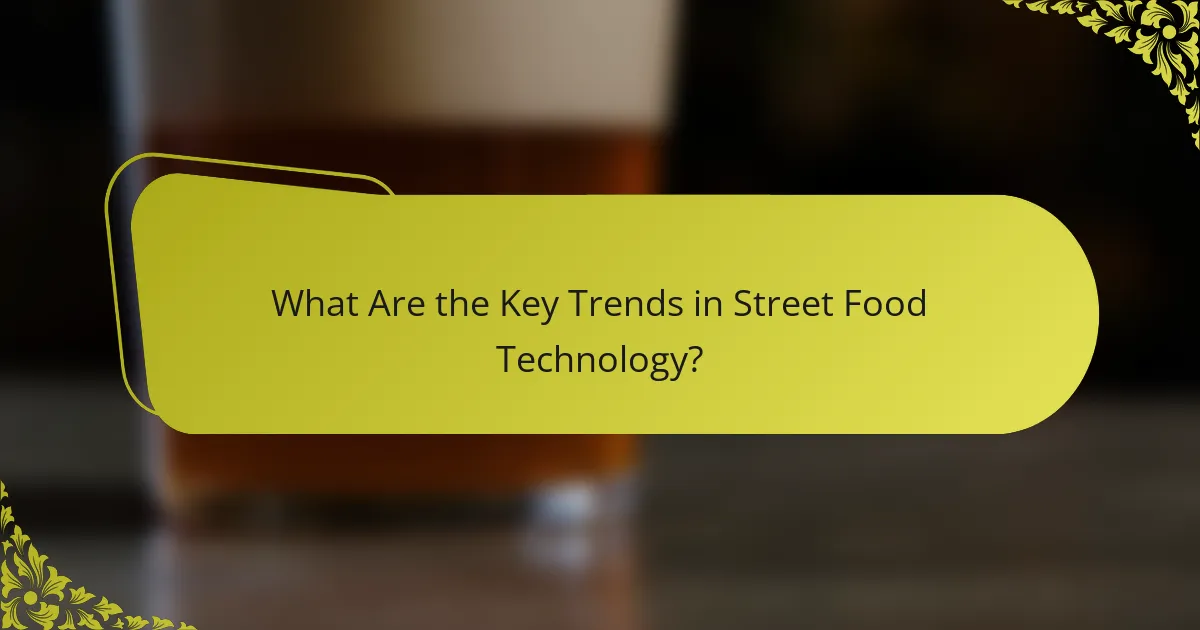
What Are the Key Trends in Street Food Technology?
Key trends in street food technology focus on enhancing customer experiences, improving health standards, and promoting sustainability. Innovations in this sector are reshaping how food is prepared, packaged, and marketed, responding to consumer demands for healthier and more environmentally friendly options.
Health-focused innovations
Health-focused innovations in street food include the use of technology to provide nutritional information and promote healthier cooking methods. Many vendors are now using apps that allow customers to view calorie counts and ingredient lists, helping them make informed choices.
Additionally, some food trucks are adopting cooking techniques that reduce fat and sugar content, such as air frying or steaming. This shift not only appeals to health-conscious consumers but also aligns with growing dietary trends like plant-based diets.
Sustainable packaging solutions
Sustainable packaging solutions are becoming essential in the street food industry as consumers increasingly prioritize eco-friendly options. Vendors are shifting from plastic to biodegradable or compostable materials, which can significantly reduce environmental impact.
Examples include using bamboo plates, cornstarch containers, or recyclable paper wraps. Implementing these solutions can enhance a brand’s image and attract environmentally conscious customers, especially in urban areas where sustainability is a key concern.
Personalized marketing strategies
Personalized marketing strategies leverage data analytics and social media to engage customers more effectively. Street food vendors are utilizing customer data to tailor promotions and menu offerings based on individual preferences and purchasing behavior.
For instance, loyalty programs that reward repeat customers with discounts or exclusive menu items can foster a sense of community and encourage repeat business. Additionally, targeted social media ads can help vendors reach specific demographics, increasing foot traffic and sales.
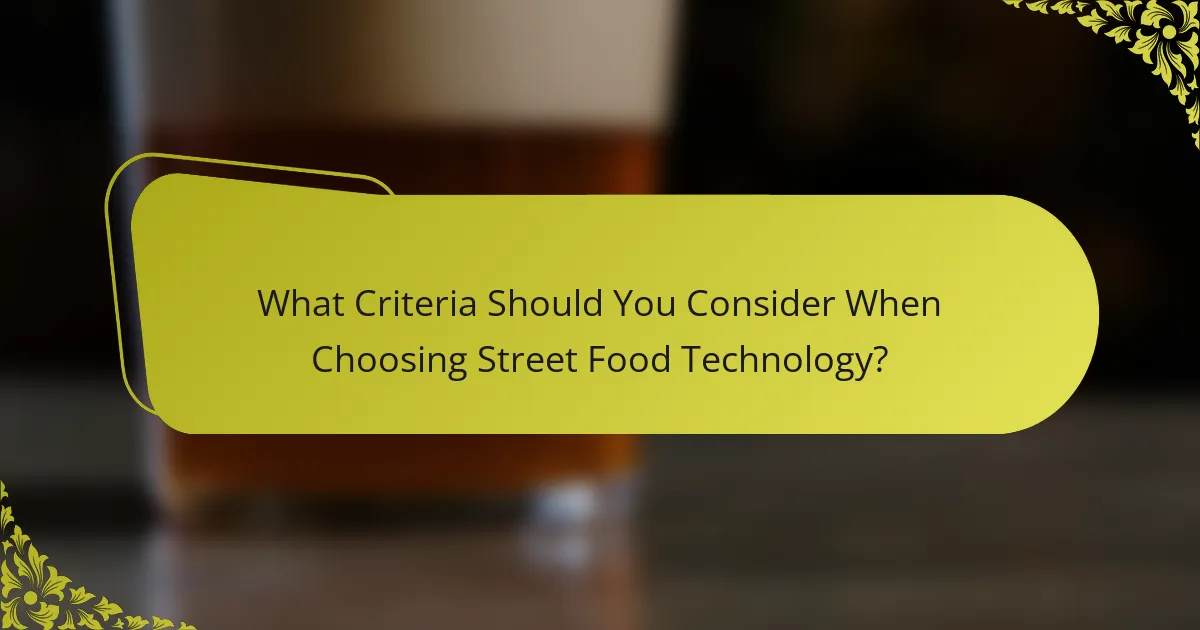
What Criteria Should You Consider When Choosing Street Food Technology?
When selecting technology for street food operations, consider factors such as cost-effectiveness, user-friendliness, and integration with existing systems. These criteria will help ensure that the technology enhances your service without complicating operations or straining your budget.
Cost-effectiveness
Cost-effectiveness is crucial when investing in street food technology. Evaluate both initial costs and ongoing expenses, including maintenance and software updates. Aim for solutions that offer a good balance between price and functionality, ensuring that your investment will yield a reasonable return over time.
For example, mobile payment systems may require upfront fees but can significantly reduce cash handling costs and improve transaction speed. Consider options that provide clear pricing structures, avoiding hidden fees that could impact your budget.
User-friendliness
User-friendliness is essential for ensuring that both staff and customers can easily navigate the technology. Look for systems with intuitive interfaces that require minimal training for employees. A user-friendly setup can enhance customer experiences, making it easier for them to place orders and make payments.
For instance, touch-screen kiosks or mobile apps with straightforward navigation can reduce wait times and improve order accuracy. Test different options to find the one that best meets your operational needs and customer preferences.
Integration with existing systems
Integration with existing systems is vital for seamless operations. Ensure that any new technology can easily connect with your current point-of-sale systems, inventory management tools, and customer relationship management platforms. This compatibility helps streamline processes and reduces the risk of operational disruptions.
For example, if you already use a specific payment processor, choose technology that supports it to avoid complications. Assess the potential for data sharing between systems, which can provide valuable insights into customer behavior and sales trends.
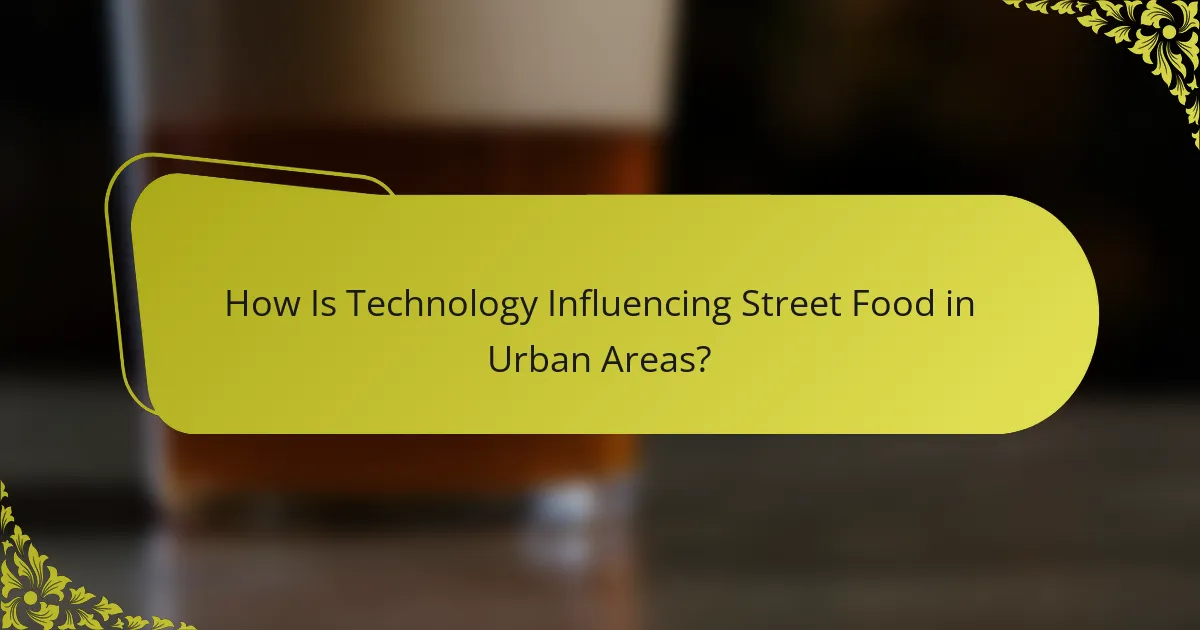
How Is Technology Influencing Street Food in Urban Areas?
Technology is significantly transforming street food in urban areas by enhancing operational efficiency, improving customer engagement, and expanding market reach. Innovations such as mobile apps, digital payment systems, and social media platforms are reshaping how vendors interact with customers and manage their businesses.
Innovations in Street Food Technology
Innovations in street food technology include the use of mobile ordering apps, which allow customers to place orders in advance, reducing wait times. Vendors can leverage these platforms to streamline their operations and increase sales during peak hours.
Additionally, food trucks are increasingly adopting GPS tracking systems that enable customers to locate them easily. This not only enhances customer convenience but also helps vendors optimize their routes and service areas.
Customer Engagement Strategies
Effective customer engagement strategies in street food often involve social media marketing. Vendors can use platforms like Instagram and Facebook to showcase their offerings, share customer reviews, and announce special promotions. Engaging content can attract new customers and retain loyal ones.
Another strategy is implementing loyalty programs through mobile apps, rewarding repeat customers with discounts or free items. This encourages ongoing patronage and builds a community around the vendor’s brand.
Challenges and Considerations
While technology offers numerous benefits, street food vendors must navigate challenges such as the cost of implementing new systems and the need for reliable internet connectivity. Vendors should assess their budget and choose technologies that provide the best return on investment.
Additionally, staying compliant with local regulations regarding food safety and digital transactions is crucial. Vendors should familiarize themselves with these regulations to avoid potential fines and ensure a smooth operation.
